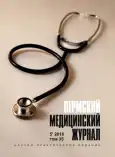Express diagnosis of connective tissue dysplasia in conditions of ambulatory-polyclinic service
- Authors: Denisov A.S.1, Zagorak D.P.2
-
Affiliations:
- Academician Ye.A. Vagner Perm State Medical University
- Regional Hospital named after Academician Ye.A. Vagner
- Issue: Vol 35, No 5 (2018)
- Pages: 36-41
- Section: Articles
- URL: https://journals.rcsi.science/PMJ/article/view/10696
- DOI: https://doi.org/10.17816/pmj35536-41
- ID: 10696
Cite item
Full Text
Abstract
Aim. To detect the most informative signs of connective tissue dysplasia (CTD) and develop the method for CTD express diagnosis in conditions of ambulatory and stationary traumatologo-orthopedic service.
Materials and methods. Sixty practically healthy persons were examined. To diagnose the connective tissue pathology, there were used the criteria developed by S.K. Evtushenko (2002), T.Yu. Smolnova (2003) and T.I. Kartunova (2006). Eighteen the most informative criteria were chosen.
Results. The paper is devoted to a widespread and yet not fully studied problem – the connective tissue dysplasia. The basic signs of this disease were analyzed. The most informative criteria of connective tissue dysplasia were singled out. Express test for primary diagnosis of this pathology in conditions of traumatologo-orthopedic service was offered.
Conclusions. Express test of the state of connective tissue structure is simple to perform. It can be used to improve surgical aids in connective tissue dysplasia, when additional stabilization of loco motor system is required.
Keywords
Full Text
##article.viewOnOriginalSite##About the authors
A. S. Denisov
Academician Ye.A. Vagner Perm State Medical University
Author for correspondence.
Email: zdp1785@yandex.ru
доктор медицинских наук, профессор, заведующий кафедрой травматологии, ортопедии и военно-полевой хирургии
Russian Federation, 26, Petropavlovskay street, Perm, 614000D. P. Zagorak
Regional Hospital named after Academician Ye.A. Vagner
Email: zdp1785@yandex.ru
врач травматолог-ортопед
Russian Federation, 12, Dementieva str., Berezniki, 618400References
- Денисов А.С. Ортопедические аспекты диагностики и лечения шейных вертеброгенных синдромов: дис.. канд. мед. наук. Пермь 1975; 28.
- Дисплазия соединительной ткани. Под ред. Т.И. Кадуриной, B.M. Горбуновой. СПб.: Элби 2009; 85-94.
- Кадурина Т.И., Горбунова В.Н. Современные представления о дисплазии соединительной ткани. Казанский медицинский журнал 2007; 88 (S5).
- Козинова О.В. Беременность и роды у больных с недифференцированной дисплазией соединительной ткани. Вопросы гинекологии, акушерства и перинатологии 2007; 6 (1): 66-69.
- Мартынов А.И. Национальные рекомендации Российского научного медицинского общества терапевтов по диагностике, лечению и реабилитации пациентов с дисплазиями соединительной ткани. Медицинский вестник Северного Кавказа 2016; 11 (1).
- Нечаева Г.И. Дисплазия соединительной ткани: основные клинические синдромы, формулировка диагноза, лечение. Лечащий врач 2008; 2: 22-28.
- Николаев К.Ю. Дисплазия соединительной ткани и полиорганная патология у детей школьного возраста. Педиатрия. Журнал им. Г.Н. Сперанского 2006; 85 (2).
- Филатова О.В., Куцева Е.В. Комплексная оценка физического развития детей периода первого детства г. Барнаула. Acta Biologica Sibirica 2015; 1 (1-2).
Supplementary files






